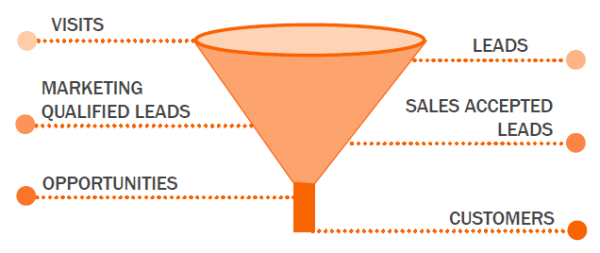If you’re a Great British Bake Off fan then you’ll know that the series’ stringent judges – Paul Hollywood and Prue Leith – tend to get stricter as things go on.
At the beginning of the show contestants can get away with a cake that leans slightly. By the final week if even the icing leans slightly then it’s game over.
MQLs and SQLs are like Great British Bake Off judging for your digital marketing leads.
How to build a successful sales pipeline by adding MQL and SQL pipeline stages
As a lead progresses through your existing digital marketing funnel – from anonymous stranger who has no idea what you do, to valued client – the criteria to make it from one stage to the next gets more and more robust.
Adding MQLs and SQLs pipeline stages to your existing funnel means that you add further useful stages to how you define and measure your leads, making sure that you’re only working with the ones that will close and be profitable.
At ‘first touch’ with your business all leads are welcome. As you learn more about the lead, some are more welcome than others. Suitable leads are given the ‘Hollywood handshake’ and progress to the next stage, whilst unsuitable leads – your wonky cakes – are sent home.
MQLs and SQLs form a useful system that more and more businesses are adopting. But like most things there are good ways to adopt MQLs and SQLs and even better ways to adopt MQLs and SQLs.
Are you completely confident that you’ve implemented MQLs and SQLs in the right way? Or are a few wonky cakes still getting through? Or are you still developing a sales pipeline and you’re yet to implement MQLs and SQLs at all? Here’s everything you need to know.

What are MQLs and SQLs?
If you’re new to the idea of Marketing Qualified Leads (MQLs) and Sales Qualified Leads (SQLs) then some more formal definitions (not involving cake) will probably help.
The MQL Definition
A Marketing Qualified Lead is a lead which the marketing function in a business has assessed, and found to meet, a set of pre-set criteria. The criteria is agreed up-front by the sales and marketing functions within a business, along with other stakeholders. Based on the agreed criteria, there is a reasonable chance that if an MQL is nurtured correctly they could turn into a customer in the future. Typically, at the point a lead has been designated an MQL, ownership of the lead would pass from the marketing team to the sales team.
The SQL Definition
A Sales Qualified Lead is a lead which the sales function in a business has assessed, and found to meet, a set of pre-set criteria. The criteria is agreed up-front by the sales and marketing functions within a business, along with other stakeholders. Based on the agreed criteria, SQLs are considered to have a good chance of converting to a customer. They have engaged with your product and service and are likely to be open to or even welcome a conversation with the sales team.
Implementing these relatively basic pipeline stages can produce plenty of positives, which is why so many businesses now use them as part of assessing their digital marketing sales funnel.
- Weed out poor-fit leads before you spend too much time on them
- Dedicate time to best-fit leads, with the highest chance of closing
- Your sales team approach people at the right time, reducing the chance of alienating a would-be client
- Clear ownership of leads between marketing and sales, reducing communication errors
To implement the MQL/SQL system into your customer lifecycle though, you need to define what an MQL and SQL mean to you.
The basic criteria to define your MQLs and SQLs
Broadly speaking the basic qualities of an MQL and SQL will normally involve the following;
Basic MQL criteria
- You know some personal details about the lead, including contact details.
- They have interacted with your marketing, often including the submission of the above details. This could have been done in order to attend a webinar or receive a whitepaper download, for example.
- There is some data which suggests they may fit one of your buyer personas.
- They are opted-in to your marketing communications.
Basic SQL criteria
- They have continued to show interaction with your marketing material after the initial ‘data acquisition’. This could include actions such as clicking on and opening emails.
- Their data has been enriched further and suggests they are tightly aligned to a buyer persona.
- They have interacted with pages on your website which indicate increased intent to purchase.
Whilst these criteria are a great start in defining exactly what MQL and SQL mean to you they should be just that: a start. Tightly honing in on your own definitions will really make the system work wonders for how you manage and close your leads.
How to build better MQL and SQL definitions
The best way to explain how you can refine your MQL and SQL definitions is through examples. Below you’ll find four suggestions for how you can add definition to your MQL and SQL structure.
MQL – Interaction with your marketing material
Tracking a contact’s interaction with your marketing material is a common way of defining them as an MQL. If a contact downloads a whitepaper, for example, then many firms will assess the data submitted. If it matches that firm’s desired persona then the download of the whitepaper is sometimes enough for the contact to achieve MQL status.
It’s probably worthwhile considering, however, if this is enough indication that a contact may be ready to buy from you and if all data submission is created equal. If a contact downloads a whitepaper then you may not be sure if they actually go on to read it. If they register for a webinar and attend it, however, you may consider this to warrant more investment in your marketing material, justifying an MQL designation.
The broad guidance here: don’t just assume all marketing interaction could constitute the contact being an MQL, even if their data suggests they are a fit.
MQL – Seniority
It’s common to see firms use the BANT methodology when it comes to assessing leads. BANT stands for Budget, Authority, Need and Timeline. If you know all of those details about a lead’s purchasing process then, the logic goes, you know whether they are likely to purchase from you.
It’s difficult to assess the B, N and T of BANT at MQL stage, before you’ve even talked to the lead, but you may find it possible to build Authority (or seniority) into your MQL process.
When submitting data there are certain data points which leads may be reluctant to hand over, such as their phone number. Indicating their broad seniority though, perhaps from a drop-down list (Assistant, Executive, Manager, Director, etc.) is unlikely to be one of those points. You can use their submission here as a contributing factor when it comes to MQL assessment, tying in your use of MQLs and SQLs with the BANT methodology.
SQL – Interaction with your sales material
For a lead to progress to SQL you will want to look for buying signals from your prospect. This could include ‘forwards movement’, from engagement with the marketing content you produce to engagement with your sales material.
Lead scoring can be useful here and elsewhere in your MQL/SQL assessment. If you are using a software like HubSpot then lead scoring works by assigning a value to actions completed by your leads. A lead visiting a blog page may be worth 10 points, but a lead visiting your pricing page may be worth 50 points and trigger an alert email to a sales rep.
Downloading case studies and making it to the checkout page could also trigger scores, which contribute towards an upper limit at which SQL status is assigned.
SQL – Neat trick: getting leads to self-identify as one of your buyer personas
If you have buyer personas in your firm (fictionalised depictions of your ideal types of client) then successfully identifying your leads as one of your buyer personas can be a high value contributor to making the lead an SQL. But how do you do it?
If you are a HubSpot user then there’s a clever way to not only make this happen but to get your lead to self-identify.
When setting up a form you can use the ‘Persona’ contact property, but edit the description and labels so they make sense to your leads. Instead of labelling the field ‘persona’, set the label as ‘Which of the following best describes you?’. Instead of your internal persona names, edit the values to be brief descriptions. For example: ‘I’m a digital marketing manager looking for inspiration’. You should also have an option that allows users to choose ‘None of these describe me well’.
By implementing this as part of your data collection you’ll really enrich your lead data, allowing you to more accurately assign the SQL lifecycle stage and sell more to better fit clients.
Reporting on your MQL and SQLs
Like almost anything else when it comes to sales and marketing there’s little point in doing something if you can’t report on what you’re doing and use your data to measure and improve your sales funnel. It’s the same with MQLs and SQLs, which is one of the points we make on our page covering creating digital marketing reports.
As a marketer MQLs and SQLs are a really useful tool to demonstrate your successes. Instead of saying you’re successful at bringing in any old leads, you can highlight you’re generating MQLs and SQLs; leads whose quality has been agreed and vetted by marketing, sales and all stakeholders.
In true M&S fashion (back to food): this isn’t just a lead; this is a marketing qualified lead.
Proactively leading the charge within your business to adopt MQL and SQL reporting normally leads to very positive results for the marketers that take on the challenge. Once you’ve done just that, how should you measure what you’re doing? What should you report on?
Judging how your MQLs and SQLs are working for you
One of the most obvious points of analysis is to look at your conversion ratio, as leads travel through your sales pipeline stages. What percentage of leads convert to MQLs? What percentage of MQLs convert to SQLs? What percentage of SQLs end up as customers? This is your sales funnel report.
Acceptable figures for each area will vary from business to business, but once you have the figures you can set out diagnosing problems and improving the situation.
If a very low percentage of leads convert to MQLs then maybe the right traffic is not arriving on your website in the first place. Maybe your content marketing efforts are misguided.
If few MQLs make it to SQLs then there could be a problem with how sales are approaching MQLs, or maybe there’s an issue with the criteria being used for MQLs.
Whatever the problem, paying close attention to these conversion rates can help you to incrementally improve other areas of your digital marketing, showing that MQLs and SQLs don’t just add definition to your lead creation efforts, they actually improve what you’re doing as well.



